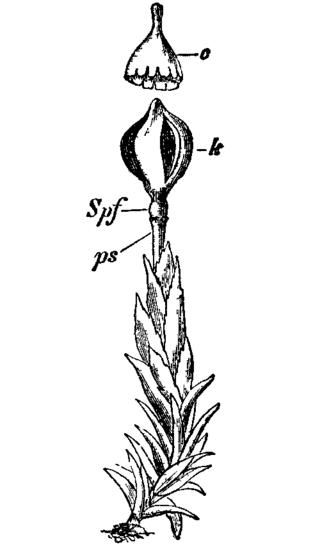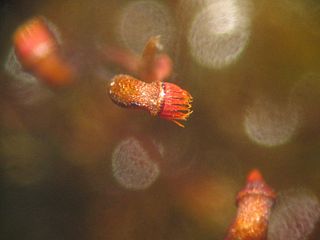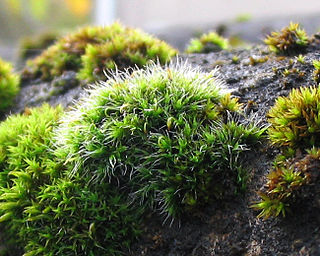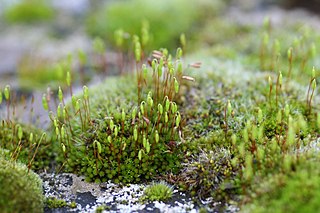
The Marchantiophyta are a division of non-vascular land plants commonly referred to as hepatics or liverworts. Like mosses and hornworts, they have a gametophyte-dominant life cycle, in which cells of the plant carry only a single set of genetic information.

Hornworts are a group of non-vascular Embryophytes constituting the division Anthocerotophyta. The common name refers to the elongated horn-like structure, which is the sporophyte. As in mosses and liverworts, hornworts have a gametophyte-dominant life cycle, in which cells of the plant carry only a single set of genetic information; the flattened, green plant body of a hornwort is the gametophyte stage of the plant.

Andreaeaceae is a family of mosses which includes two genera, Andreaea, containing about 100 species, and the genus Acroschisma. The Andreaeaceae prefer rocky habitats ranging from tropical to arctic climates, on which they form tufted colonies, typically with reddish to blackish shoots. The capsules lack the peristome mechanism and dehisce longitudinally to release the spores, resulting in a paper-lantern appearance.

The Bryopsida constitute the largest class of mosses, containing 95% of all moss species. It consists of approximately 11,500 species, common throughout the whole world.

Grimmiales is an order of mosses in the subclass Dicranidae. It comprises four families: Grimmiaceae, Ptychomitriaceae, Seligeriaceae, and Saelaniaceae.

Sphagnopsida is a class of mosses that includes a single subclass Sphagnidae, with two orders. It is estimated it originated about 465 million years ago, along with Takakia. The order Sphagnales contains four living genera: Ambuchanania, Eosphagnum, and Flatbergium, which counts four species in total, and Sphagnum which contains the rest of the species. The extinct Protosphagnales contains a single fossil species.

Pottiales is an order of mosses in the subclass Dicranidae.

Bryales is an order of mosses.
Gigaspermaceae are a family of mosses in the monotypic order Gigaspermales. The order is placed in subclass Gigaspermidae of the class Bryopsida. They were previously placed in subclass Funariidae.

Encalyptales is an order of mosses in subclass Funariidae. It contains a single family.

Dicranales is an order of haplolepideous mosses in the subclass Dicranidae.

Bryaceae is a family of mosses.

The Pottiaceae are a family of mosses. They form the most numerous moss family known, containing nearly 1500 species or more than 10% of the 10,000 to 15,000 moss species known.
Daltoniaceae is a family of moss in the order Hookeriales.

Mniaceae is a moss family in the order Bryales.
Ptychomitriaceae is a family of mosses in the subclass Dicranidae.
Erpodiaceae is a family of haplolepideous mosses (Dicranidae) in the order Dicranales. It consists of six genera.
Rhachitheciaceae is a family of haplolepideous mosses (Dicranidae)s in the order Dicranales. It consists of seven genera.

Ditrichaceae is a family of haplolepideous mosses (Dicranidae) in the order Dicranales.
Gigaspermum is a genus of moss in the family Gigaspermaceae. It contains four species.













